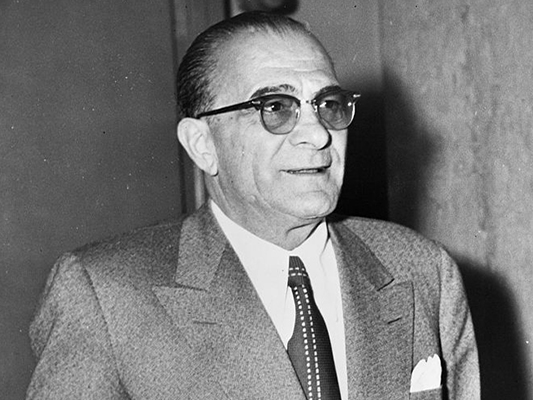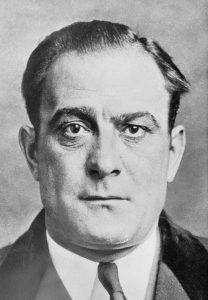Vito Genovese

Born: November 27, 1897, Tufino, Italy
Died: February 14, 1969, Springfield, Missouri
Nicknames: Don Vito
Associates: Charles “Lucky” Luciano, Joe Masseria, Joe Valachi
An American Mafia don with a complex legacy, Vito Genovese was ruthless, ambitious and power hungry, remembered as much for his heavily feared reputation as for being at least partially responsible for the downfall of organized crime in the United States in the latter half of the 20th century.
Genovese was one of the most powerful Mob lords of his day, but his desire to be named “Boss of Bosses” — chairman of the Commission, the Mafia’s national governing body — led to the secret society’s unmasking at the infamous Apalachin Summit in 1957, as well as from the public testimony of one of his lieutenants, Joseph Valachi, the first “made” man to ever admit the Mob’s existence in a public forum. When Valachi spoke in front of a U.S. Senate committee in 1963, he revealed details about the Mafia that had for decades been shrouded in myth and mystery. Both incidents were crushing blows to the brand of organized crime Genovese and his underworld contemporaries subscribed to.
Born near Naples in Italy, Genovese came to New York City when he was 15 years old. His family settled in Manhattan’s Little Italy neighborhood near Mulberry Street. By the time he was 19, he had his first conviction in his new country (a one-year stint behind bars for illegal gun possession) and had made fast friends with future Mafia visionary Charles “Lucky” Luciano, at that time a fellow aspiring wiseguy. Genovese went on to become Luciano’s most reliable and trusted enforcer and hitman. As Luciano’s star rose, so did Genovese’s. They literally killed their way to the top.
Going to work for Little Italy’s Prohibition-era godfather Giuseppe “Joe the Boss” Masseria, the pair grew to be two of Masseria’s main lieutenants. In 1930, Masseria is alleged to have tapped Genovese to murder Bronx-based Mob chief Tommy Reina, a Masseria ally suspected of conspiring with Masseria’s archrival, Salvatore Maranzano. The following year, as Masseria and Maranzano squared off for underworld supremacy in New York in a bloody conflict called the Castellammarese War (Castellammarese was the region of Sicily where Maranzano and his supporters traced their roots), Genovese was part of a hit team that assassinated Masseria in a Coney Island restaurant. Luciano and Genovese quickly turned their attention to Maranzano, who thought they were on his side, but in fact remained his enemies.
The pair successfully conspired to have Maranzano slain in his office in the fall of 1931, and upon taking complete control of the Mob in New York, Luciano created the Commission and the Five Families at a conference of the country’s biggest godfathers hosted by Luciano at a luxury hotel in Chicago. With Luciano assuming command of one of the five freshly minted New York crime syndicates, he named Genovese his underboss, or No. 2 in charge.
Following his wife dying of tuberculosis in late 1931, Genovese killed an associate and married the man’s widow, a woman he openly coveted, two weeks later in the early spring of 1932. His reputation for viciousness was only enhanced.
When Luciano was sent to prison for running prostitutes in 1936, Genovese was promoted to acting boss of the crime family. He was only in the job for a year when he fled the United States for Italy, worrying he was on the verge of being indicted for the 1934 murder of Ferdinand Boccia, an associate of Genovese who fell out with him over a rigged card game.

While in Italy, Genovese kept his Mafia profile high, dabbling in numerous black market rackets, forging ties with Italian and Sicilian dons, keeping his criminal empire back in New York growing through acting boss Frank Costello, a notorious underworld fix-it man and political point man. Genovese even aligned himself with Benito Mussolini, the Italian dictator. According to FBI records, Genovese gave the okay for the January 1943 slaying of anti-Mussolini newspaper reporter Carlo Tresca in front of Tresca’s newspaper office in Manhattan. After World War II began, Genovese offered his help to the U.S. military in the war effort in Italy.
Genovese was arrested by Italian authorities for a stolen-property ring involving a U.S. Army base in August 1944. Not long after, he was back in New York to face charges for the Boccia murder from more than a decade before. He was indicted in June 1945 in the wake of the FBI gaining the cooperation of Genovese assassin Ernie “The Hawk” Rupolo months earlier. Held in government custody for the next year, the case against Genovese fell apart when two other key witnesses were slain on orders of Genovese, and he was released in the summer of 1946, rejoining Costello on the streets in New York atop the Luciano crime family, a syndicate that would go on to bear Genovese’s name before the end of the next decade. Rupolo was executed for the betrayal in the 1960s.
Genovese ordered Costello killed in May 1957, a hit attempt that failed but nonetheless pushed Costello into retirement. Later that same year, Genovese conspired to have fellow New York City boss Albert Anastasia murdered so he could gain command of the Commission. Anastasia was slain while sitting in his barber’s chair about to have a shave in October.
In order to solidify his power play, Genovese called for a meeting of Mafia dons in November at the Apalachin, New York, estate of Pennsylvania crime boss Joseph Barbara. The summit turned into an epic public relations disaster when local cops raided the conference of godfathers. More than 60 mobsters were nabbed.
Indicted for narcotic trafficking, Genovese was convicted in 1959 and sentenced to 15 years in federal prison. He wouldn’t leave alive. Genovese died of a heart attack on Valentine’s Day in 1969 in a prison hospital in Missouri. He had feuded with Joe Valachi, Tommy Reina’s son-in-law, behind bars. In 1962, fearing that Genovese wanted him dead, Valachi, a hijacking specialist turned government witness, revealed the inner workings of the Mafia, effectively bringing down the curtain on organized crime’s “Golden Era.”
The Genovese crime family is still operating today in New York City, engaging in an array of criminal rackets, including schemes involving Wall Street and the Internet.




